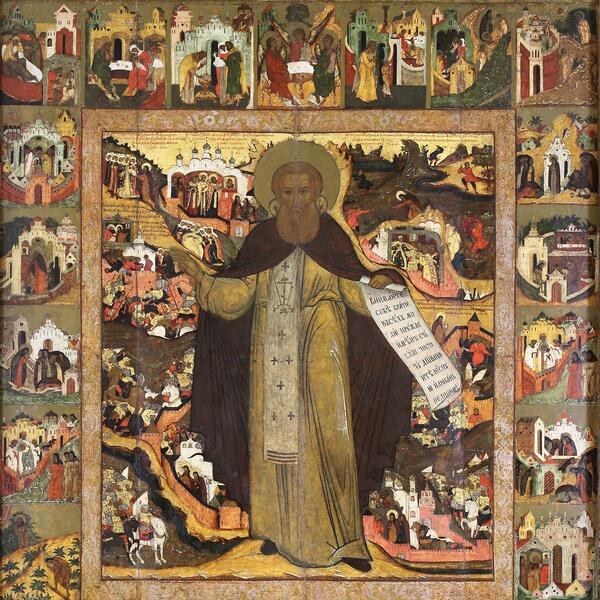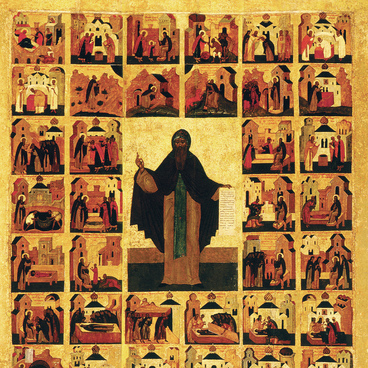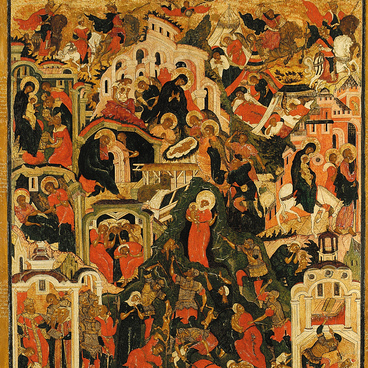This icon is the only hagiographical image of Sergius of Radonezh in Old Russian icon painting that illustrates two editions of the life of Sergius and “The Tale of the Rout of Mamai”. The icon came from the destroyed Trinity Church of the Vlasyevsky parish.
This unique icon celebrates Sergius of Radonezh as a monk, founder of monasteries, wonderworker, and an active participant in the Russian political life who was considered a spiritual leader during his life and a protector of the Russian lands after his death. Prince Dmitry Donskoy asked for his blessing before the Battle of Kulikovo. Other disciples of Sergius were also among the participants of the battle, including the venerable warriors Alexander Peresvet and Andrey Oslyaba. When the Holy Trinity-St. Sergius Lavra was besieged during the Time of Troubles, Saint Sergius repeatedly appeared before the monastery’s defenders to support them and give them strength with his prayers.
The icon was created by three painters. The main figure of the centerpiece and the 24 surrounding hagiographical border scenes were painted by a Moscow artist in the late 16th century. The historical scenes in the centerpiece were added by another artist from Yaroslavl. They were created in the second half of the 17th century. Finally, the additional bottom board depicting the Battle of Kulikovo of 1380 was painted by the third artist from Yaroslavl in the late 17th century.
The border scenes were based on the canonical hagiography of Sergius of Radonezh. It was written 26 years after the saint’s death by Epiphanius the Wise and later rewritten by Pachomius the Serb (Logothetes). Moreover, in painting the scenes of the centerpiece, the artist was guided by the rare hagiography compiled by Simon Azaryin, the cellarer of the Holy Trinity Lavra, in 1636. The extension depicting the Battle of Kulikovo was attached to the main board later.
The story of the Rout of Mamai is based on the widespread version of the tale. The paintings demonstrate many scenes, including the principalities that sent their forces, the duel between Peresvet and Chelubey, as well as the forces of Khan Mamai advancing to Russia.
This is the only image of the Battle of Kulikovo in Russian icon painting. Apart from its connection with the life of Saint Sergius, it celebrates the unity of Russian lands facing a common enemy.
This unique icon celebrates Sergius of Radonezh as a monk, founder of monasteries, wonderworker, and an active participant in the Russian political life who was considered a spiritual leader during his life and a protector of the Russian lands after his death. Prince Dmitry Donskoy asked for his blessing before the Battle of Kulikovo. Other disciples of Sergius were also among the participants of the battle, including the venerable warriors Alexander Peresvet and Andrey Oslyaba. When the Holy Trinity-St. Sergius Lavra was besieged during the Time of Troubles, Saint Sergius repeatedly appeared before the monastery’s defenders to support them and give them strength with his prayers.
The icon was created by three painters. The main figure of the centerpiece and the 24 surrounding hagiographical border scenes were painted by a Moscow artist in the late 16th century. The historical scenes in the centerpiece were added by another artist from Yaroslavl. They were created in the second half of the 17th century. Finally, the additional bottom board depicting the Battle of Kulikovo of 1380 was painted by the third artist from Yaroslavl in the late 17th century.
The border scenes were based on the canonical hagiography of Sergius of Radonezh. It was written 26 years after the saint’s death by Epiphanius the Wise and later rewritten by Pachomius the Serb (Logothetes). Moreover, in painting the scenes of the centerpiece, the artist was guided by the rare hagiography compiled by Simon Azaryin, the cellarer of the Holy Trinity Lavra, in 1636. The extension depicting the Battle of Kulikovo was attached to the main board later.
The story of the Rout of Mamai is based on the widespread version of the tale. The paintings demonstrate many scenes, including the principalities that sent their forces, the duel between Peresvet and Chelubey, as well as the forces of Khan Mamai advancing to Russia.
This is the only image of the Battle of Kulikovo in Russian icon painting. Apart from its connection with the life of Saint Sergius, it celebrates the unity of Russian lands facing a common enemy.



